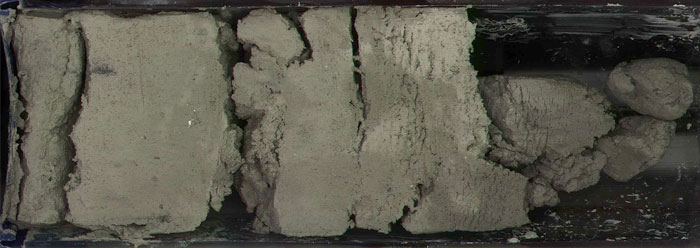Scientists found DNA in two undersea sediment drill cores from the Bering Sea.1 The researchers thought the chloroplast DNA (cpDNA) must have come from near-surface light-gathering organisms like diatoms, and not mud-dwelling organisms like bacteria. Discovering cpDNA from dead diatoms near the top of the seafloor presents no challenge, but these researchers found it hundreds of meters down. Long-age believers insist that hundreds of meters of sediment require at least hundreds of thousands of years to deposit. Given that DNA degrades relatively quickly, the team faced the significant challenge of explaining how DNA could persist long enough to get buried beneath that much sediment.
In the journal Geology, the three scientists described the DNA samples that came from various depths. Other researchers gave each an assigned age of over a million years.1 DNA is not supposed to last that long. Not even close.
The trio referenced a 2012 report led by Morten Allentoft, now with the Natural History Museum of Denmark's Centre for GeoGenetics. Allentoft used carbon dates of extinct moa (giant, flightless bird) bones to calibrate a mitochondrial DNA decay rate, finding its half-life at only 521 years.2 The Geology study authors therefore had to admit to "large differences between 100 yr and 100 m.y. time scales…."1
The Bering Sea DNA they discovered joins prior finds that similarly challenge deep time. The authors briefly described examples of DNA and RNA preservation from sediments thought to be as much as 2.7 million years old. They wrote, "In general, genetic studies of material that pre-dates the Quaternary [i.e., more than 2.6 million years old] are at odds with the current understanding of DNA preservation, especially in wet environments."1
Clearly, DNA decays in hundreds of years at Earth-surface temperatures, but scientists find DNA that apparently lasted over a million years. How can this be?
The Geology authors suggested that DNA decays fast at first—at rates like the Allentoft study showed—but then later somehow decays at a much slower rate. Did the assumption of vast ages drive this speculation, or did scientific observations? The authors acknowledged that they did not know how DNA could swap decay regimes like this, which means they apparently have no scientific basis for claiming the slower rate of decay.
Perhaps other explanations would better explain this deeply buried DNA.
Possibly the DNA came from recent sources, like burrowing bacteria. The Expedition 323 scientists of the Integrated Ocean Drilling Program who originally extracted the cores back in 2009 published a series of reports describing their drill cores. One summary paper available on the project website says,
The sediments are generally highly bioturbated. However, fine-scale lamination preserving alternations between millimeter scale laminae of biogenic and terrigenous material are also present at several of the drilled sites.3
Bioturbation refers to organisms that disrupt layering patterns as they burrow through sediments. But these organisms would have needed to burrow through hundreds of meters of sediment over numerous generations to contaminate these deep sediments with DNA—highly unlikely.
That again dredges up the problem of finding DNA right where it shouldn't be, unless the secular scientists gave wrong ages to deep mud layers. This raises a key question. How did these scientists determine the age of this deeply-buried mud in the first place? They mostly relied on biostratigraphy.
Several experts have exposed serious flaws in biostratigraphy, which begins with textbook descriptions of when a particular organism flourished during its supposed evolutionary past.4 The age assignment process begins with age ranges from printed pages. Date specialists apply the printed ages to rock or mud layers that contain corresponding fossils.
But what if God made these creatures? What if they never evolved? Biostratigraphy rests on assuming an evolutionary past—the main flaw with biostratigraphy. This dating procedure assumes the very age that it attempts to prove!
The poor, circular logic of biostratigraphy opens the door to the possibility that these marine sediments are much younger than secularists will admit. And the discovery of fossil DNA hundreds of meters down confirms the younger age. How can DNA that originated at the sea surface persist at great depths? This evidence fits the idea that this mud took just thousands of years to accumulate—not a million.
References
- Kirkpatrick, J. B., E. A. Walsh, and S. D'Hondt. 2016. Fossil DNA persistence and decay in marine sediment over hundred-thousand-year to million-year time scales. Geology. 44 (8): 615–618.
- Thomas, B. Bone DNA Decays Too Fast for Evolution. Creation Science Update. Posted on ICR.org October 24, 2012, accessed August 2, 2016.
- Takahashi, K., A. C. Ravelo, C. A. Alvarez Zarikian, and the Expedition 323 Scientists. Expedition 323 summary. Proceedings of the Integrated Ocean Drilling Program. Volume 323. Integrated Ocean Drilling Program Management International, Inc.
-
For example, geologist John Reed listed these seven revealing problems with biostratigraphy in his 2013 book Rocks Aren't Clocks. Powder Springs, GA: Creation Book Publishers, 127:
1) This method depends on evolution. Any uncertainty about evolution translates into uncertainty about biostratigraphy.
2) Even if evolution is true, biostratigraphy depends on the rocks showing a representative record of evolutionary progress.
3) The fossil record as we know it does not show intermediate or transitional forms that show the evolutionary steps.
4) Using evolution to arrange the fossils and then claiming that the order of the fossils proves evolution is circular reasoning.
5) Evidence of catastrophic deposition implies the absence of 'paleoenvironments' which are the basis of the calim that the rocks show historically-reliable snapshots of the past.
6) Living fossils, such as the coelacanth, contradict evolutionary biostratigraphy.
7) The new practice of setting age boundaries by Global Stratotype Section and Points, or 'GSSPs' shows a lack of faith in conventional biostratigraphy.
Image credit: Copyright © 2009 Integrated Ocean Drilling Program. Texas A&M University. Adapted for use in accordance with federal copyright (fair use doctrine) law. Usage by ICR does not imply endorsement of copyright holder.
*Mr. Thomas is Science Writer at the Institute for Creation Research.
Article posted on August 18, 2016.























